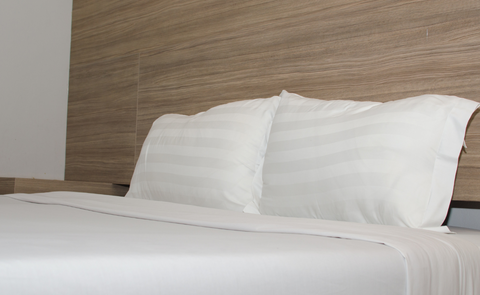Have you ever woken up with a stiff neck or persistent shoulder pain? You might be surprised how often these discomforts trace back to the pillow you rest on each night. What makes a good pillow? It’s not just about fluffiness—there’s so much more to it than that. You’re looking for a pillow that adapts to your sleeping position, supports your neck and spine alignment, and suits your personal preferences. In this guide, you’ll discover what truly defines a quality pillow and learn how to pick one that improves your sleep.
Drawing inspiration from top competitor blogs, you’ll find that each source emphasizes one key theme: choose a pillow that addresses your unique physical needs and preferences. You’ll also notice there’s no one-size-fits-all pillow—what’s perfect for you depends on factors such as your sleeping style, level of firmness you prefer, and how the pillow materials affect heat retention and breathability. By the end of this guide, you’ll be ready to make an informed decision that elevates your nightly comfort.
A Look at Pillow Anatomy
When you start exploring pillow options, you’ll quickly see there are many different parts and layers. The core components generally include:
-
Cover Fabric: Often made from cotton, polyester blends, or specialized materials designed for cooling or allergy relief.
-
Fill or Stuffing: This is what provides structure and feel. From memory foam to down feathers to synthetic fibers, each fill creates a different sleep experience.
-
Shape and Size: Standard, queen, and king are the most common sizes, but there are also specialized shapes for cervical (neck) support or for side sleepers.
A good pillow integrates these elements in a way that feels comfortable to you and properly supports your head, neck, and upper spine. That is the foundation of what makes a pillow “good.”
The Importance of Proper Alignment
Keeping Your Neck Supported
Your spine has a natural curvature, and you want your pillow to maintain that curve while you rest. If your head sinks too low or gets propped up too high, you’ll likely wake up feeling stiff. A pillow that correctly aligns your head and neck with your spine is crucial for preventing those aches and pains.
-
For Back Sleepers: You typically need a medium-loft pillow—thick enough to fill the gap between your neck and the mattress, but not so high that your chin angles toward your chest.
-
For Side Sleepers: You’ll generally need a higher-loft pillow to support the distance between your ear and outer shoulder. Some pillows are specifically designed to keep side sleepers’ necks level.
-
For Stomach Sleepers: A lower-loft pillow helps keep your neck in a more neutral position. Some stomach sleepers even do well with extra-thin or nearly flat pillows.
Reducing Tossing and Turning
When your pillow is too soft or too firm, you’re more likely to shift positions frequently in the night, looking for relief or comfort. A well-chosen pillow reduces the urge to toss and turn, helping you stay in a healthier sleep posture and promoting deeper, more restorative rest. After all, your pillow isn’t just a headrest—it’s an essential part of your nighttime posture.
Types of Pillow Filling
Memory Foam
Memory foam pillows contour closely to your head and neck. You might love this option if you prefer a snug cradle that reduces pressure points. Some memory foam pillows come as a single piece of foam, while others feature shredded foam for adjustable loft and better airflow. If you’re a side sleeper needing extra support, a memory foam pillow could be just what you need.
Down and Feather
Down and feather fillings offer plushness and superior softness. Down often comes from the soft undercoating of ducks or geese, making it extremely fluffy. Feather pillows, which contain the outer feathers of birds, typically feel a bit firmer. If you want the luxurious, cloud-like feel of hotel pillows, you’ll appreciate down and feather fills. However, keep in mind they may require frequent fluffing to maintain shape.
Synthetic Fill
Polyester or other synthetic fills often mimic the softness of down at a more budget-friendly price point. They tend to be lighter than memory foam and may feel cooler if you often overheat at night. On the downside, synthetic pillows may compress or flatten more quickly over time, so be prepared to replace them sooner than some other types.
Latex
Latex pillows are known for durability and consistent support. If you value resilience and want a natural material, latex might be an excellent choice. These pillows also bounce back faster than memory foam, so you won’t experience the “sinking in” feel. Plus, latex is naturally breathable, helping you stay cool at night.
Choosing the Right Firmness
Just like mattresses, pillows come in various firmness levels—usually classified as soft, medium, or firm. Your firmness preference often depends on both your sleeping position and personal comfort. Side sleepers might prefer a medium or slightly firm pillow to fill the gap between ear and shoulder. Back sleepers often opt for medium-firm pillows that keep the neck from craning. Stomach sleepers usually find that softer, flatter pillows reduce neck strain.
Considering Your Preferred Sleep Temperature
Do you find yourself flipping your pillow to the “cool side” multiple times a night? Temperature regulation is a critical factor for many people. Certain fills like latex, buckwheat, or specialized cooling gel memory foam allow for better airflow. Breathable covers, like cotton or certain performance fabrics, can also help dissipate heat. If you frequently wake up sweaty, a pillow designed for cooling can be a game-changer.
Height and Size Matter
Loft and Pillow Height
You might see the term “loft” used frequently in pillow descriptions. Loft refers to how tall or thick a pillow is when it’s resting flat on your bed. A higher loft suits broader shoulders (especially for side sleepers), while a lower loft accommodates smaller frames or stomach sleepers. Selecting the right loft ensures your head remains in a neutral position rather than tilting too far up or down.
Standard vs. Specialty Sizes
Pillows commonly come in standard, queen, and king sizes. While the difference in length may not affect your sleep significantly, it can influence how your bedding looks and fits. Some specialty pillows have unique shapes or designs, such as ergonomic or contoured options, to help alleviate neck or back issues. Evaluate the pillow’s shape based on your specific sleep challenges, not just your mattress size.
Durability and Longevity
You’ll likely rest your head on the same pillow for hours each night, so longevity is key. A high-quality pillow maintains its structure and support over time without significant flattening. Materials like latex and memory foam tend to hold up well, while synthetic or budget fills might collapse more quickly. Regular maintenance—such as fluffing, airing out, or spot-cleaning—can extend the life of many pillows. Always check the care instructions provided by the manufacturer so you know how to keep your pillow in top shape.
Allergen Considerations
If you have allergies, you might want to think about hypoallergenic or dust mite-resistant pillows. Some pillows come with covers or fills that help repel common allergens. Synthetic and latex fills are often less likely to trigger allergies compared to down or feather pillows. Washing your pillow cover regularly also helps minimize allergens, contributing to an overall cleaner sleep environment.
Matching Your Pillow to Your Sleep Environment
Pairing with a Good Mattress
Even the best pillow can’t fully compensate for a poor mattress. Think of your bed setup as a holistic system. If your mattress sags or doesn’t provide adequate support, you may still wake up with discomfort. The right combination of mattress, pillow, and other bedding choices (like a breathable sheet set) creates an environment where you’re best positioned to sleep soundly.
Lighting and Noise
Your pillow’s job is to enhance comfort, but you’ll also sleep better in a room that’s well-designed for rest. While this doesn’t directly impact your pillow selection, consider your bedroom’s overall ambiance. Dim lighting, minimal noise, and a comfortable pillow form a trifecta of better sleep hygiene. You’re more likely to feel the difference a quality pillow makes if you also address other disruptive factors.
Testing and Replacing Your Pillow
It’s wise to try out a new pillow for a few nights—some sellers even offer trial periods. Pay close attention to whether you wake up with any new aches or if you toss and turn less. Over time, pillows wear down and accumulate dust or oils, so replace them as recommended by the manufacturer. For most pillows, that’s anywhere from one to three years, though some can last longer with proper care.
Final Thoughts on Finding the Perfect Pillow
Your comfort is highly personal—only you can determine which combination of materials, loft, firmness, and size delivers the best rest. By focusing on spine alignment, temperature regulation, and the right fill, you set yourself up for success. The question of “What makes a good pillow?” hinges on how well it meets your needs: ensuring your neck and head are supported in a comfortable, healthy position throughout the night.
Take stock of your current sleep experience. Do you need more support? Are you craving a softer surface or perhaps a more resilient one? Use these insights to guide you as you shop. When you choose a pillow that aligns with your sleep style, you’ll wake up refreshed and ready to take on each new day. Ultimately, the right pillow is the one that makes your nights more restful and your mornings more invigorating—offering gentle support where it counts.



